I do follow the work being done by the San Diego River Park Foundation and other groups, but perhaps I can offer some personal experience in restoration techniques for which I have done before in Riparian restoration. This sign below is where I have on example seen my trip the chocking of invasive plants like Tamarisk in places like the San Diego River in Lakeside California. Although I must say that I have neither heard nor read about any programs to eradicate this riparian habitat menace. I've previously written about this plant Here , but I in no way blame it for the problems facing southwestern ecosystems problems. I put it squarely on the shoulders of those responsible for the present fiasco, humankind.
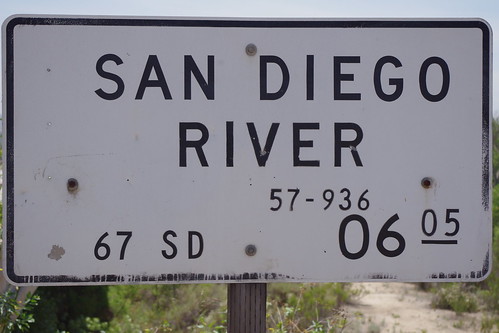 |
| Photo: Mine |
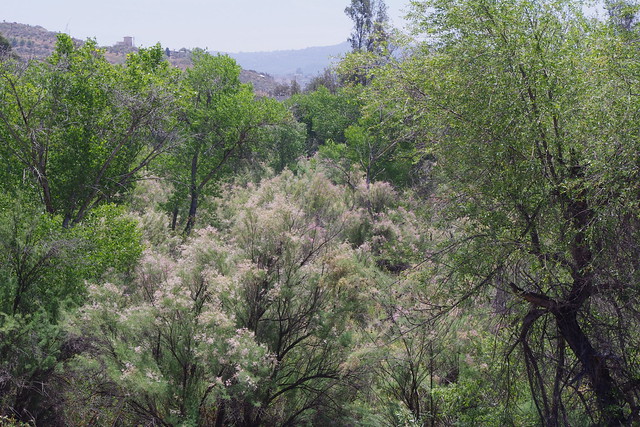 |
| photo: Mine |
 |
| photo: Mine |
Both of the above photos are of the view from the Hwy 67 bridge in Lakeside California looking eastward towards El Capitan High School and the El Monte Valley beyond. The Tamarisks are very heavily growing even on the the east side of Ashwood St where it crosses the San Diego River and before it turns into Wildcat Canyon Road.
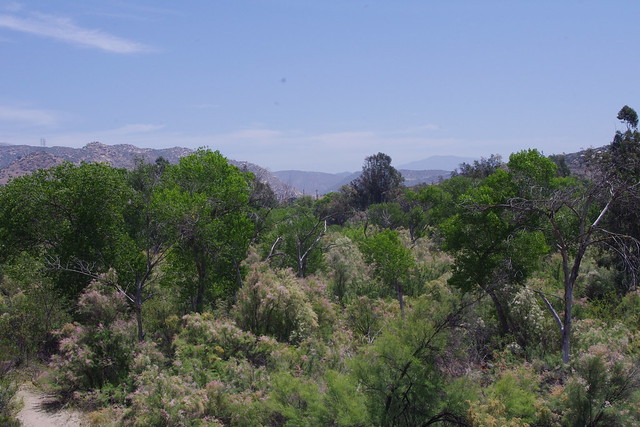 |
| photo: Mine |
Looking west towards the direction of Santee California from the Hwy 67 bridge in Lakeside California. Mostly we are looking towards Cowles Mountain way off i the distance, but also the backside of Rattlesnake Mountain over on the left side of the photo.
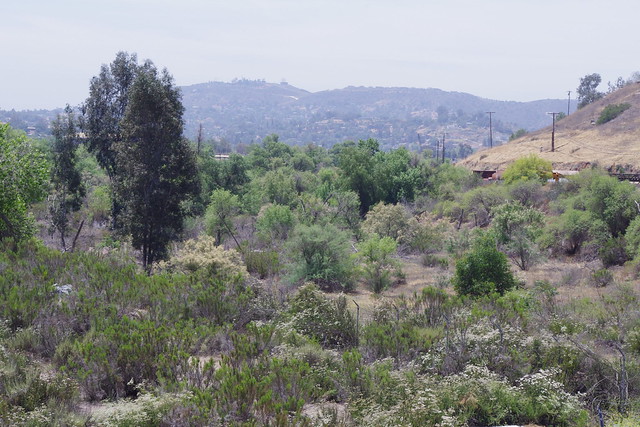 |
| photo: Mine |
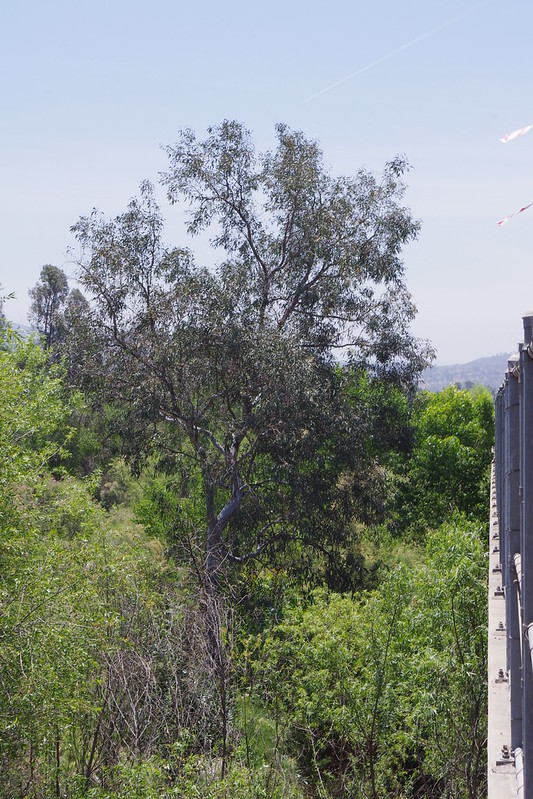 |
| photo: Mine |
Also, timing of eradication would have to coincide with Seed dispersal which fortunately has only a small window of viability for germination to be successful. (I believe no more than 30 days) This could actually be an advantage. The other problem I see with Tamarisk woodland thickets which crowd out riparian natives is that from what I have observed, they are a greater mega-fire risk than pure riparian species which often act as a fire barrier and if nothing else at least slow an advancing fire down as far as it's rapid progress. Anyone who has ever witnessed a Tamarisk woodland burn knows that it burns with an intensity generally associated with Chaparral. This makes for another reason it needs to be completely eradicated. Mechanical removal and possibly burning the stumps out through a charcoal method in wintertime when they are dormant may be the only way. But you cannot leave any live roots which will re-sprout. I would definitely forbid the use of chemical treatments with products like Roundup which already contain warnings for usage in and around Riparian areas anyway. The root systems easily sprout back as they do when fire pushes through an area, so it is imperative to destroy as much of that infrastructure as possible. Other trees like removal of Eucalyptus and Fan Palms would be a no brainer. However, once removal is completed, there must be a rapid rush towards replacement with native species and quickly. This is where proper planning and acquisition of 1000s of various plants would have to be on the ready. Now take a look below at some places where specimens could be obtained.
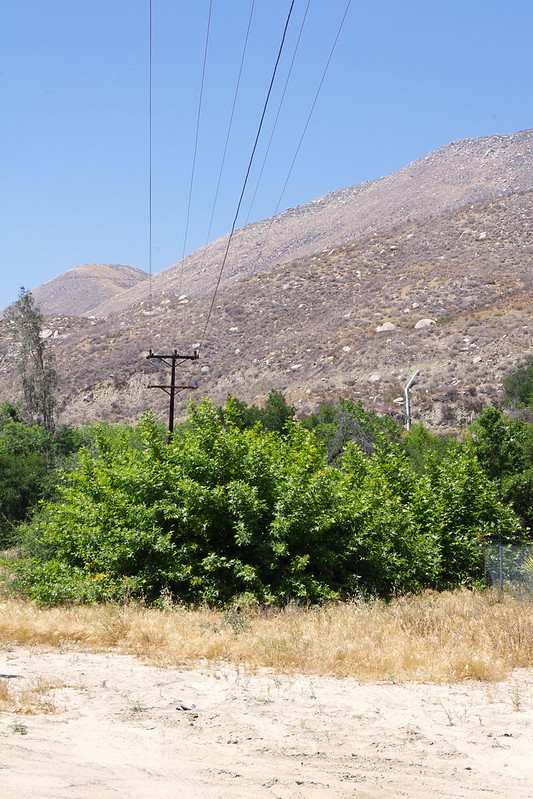 |
| Photo Credit: Mine |
These aggressive suckering sprouts are California Sycamores on the north side of California State Route 74 leaving Hemet towards Idyllwild. The Power Utility Edison has been battling with these poor trees for decades. In the early days, these two specific trees still had large trunks and were topped off just under the power lines, but passing by a few weeks back I noticed they were aggressively dealt a heavier blow all the way to the ground. So every year thereafter, the maintenance crews come along and butcher these poor trees in the Chop Shop (Asplundh) fashion of many a commercial Tree Butchering company who are subcontracted to do nothing more than remove living vegetation away from anything concerning utility right-of-way. There is no care given to aesthetics, it's strictly a what's necessary only for business. I could name the well known companies, but you folks out there already know who they are.
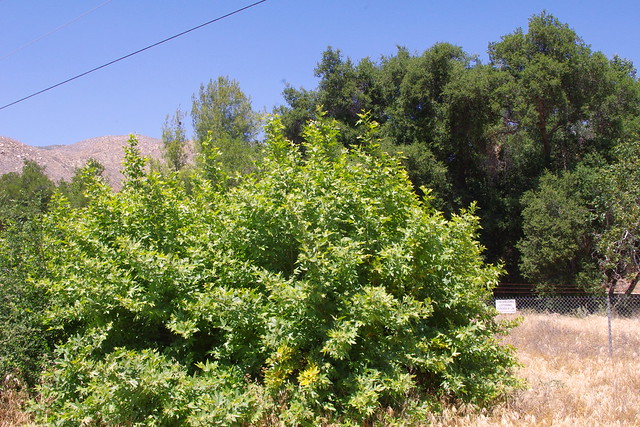 |
| Photo: Mine |
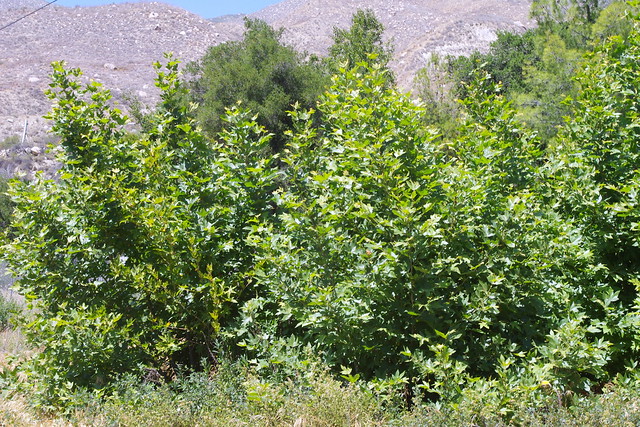 |
| Photo: Mine |
Cutting inch to two inch poles for planting which is merely harvesting extremely cane long poles, can be a major head start of sorts if done correctly and babied with care that first year or two. Sycamores, like Willows and Cottonwoods have an amazing rooting propagation adaptation which allows a branch to be broken off during high flood periods and become buried way down stream only to re-sprout a new tree somewhere else. They have a high growth hormonal content within their tissues. Some folks even make a tincture of willow bark as a natural rooting hormone for other unrelated plant cuttings for their gardens. While excessively large cane poles which may even require a boring agar with tractor may seem extreme overkill, I believe such techniques will become more and more necessary as time and deterioration of various ecosystems picks up the pace. If the present failed System of Things persists for very long, Mankind will become more and more forced into desperate & dire circumstances where such major forcing techniques will become necessary to accomplish things they should have done decades ago. One such rapid riparian establishment technique is being used in Arizona with both the Fremont Cottonwood (Populus fremontii) and Arizona Sycamore (Platanus wrightii) where surface water is 7 to 15 foot below the surface in dry washes, but which have a moist subsoil layer. They do recommend to cutting 20 foot cane poles, pre-soaking in water and planting at least two thirds of the pole in the deep drilled planting holes. Again, this may sound extreme, but the extreme countermeasures must be forced for a rapid repair of long ago destroyed former riparian habitats. Here's a link to some of the recommendations given by some government agencies.
Source: Cooperative National Park Resources Studies Unit Arizona
PROPAGATION
"Plants may be propagated either by seed germination (see section on Germination Requirements) or by cuttings. The greatest results for cuttings are from one year old vigorously growing seedlings, for which there is a 66-80% success rate (Fowells 1965). Fowells (1965) suggests fall plantings of cuttings made close to the root collar that are 20 inches (50.8 cm) long, buried 15 inches (38.1 cm) into the ground. For areas in Arizona where groundwater is 7-12 feet (2-4 meters) below the surface, a new method of propagation has been tried that might be successful with Arizona Sycamore. Twenty foot (6 meter) long poles were planted in drilled holes with 4-6 feet (1.2-1.8 meters) extending above the ground, leaving 14-16 feet (4.3-4.8 meters) below ground and penetrating into the groundwater. Poles were 2-3 inches (5-8 centimeters) in diameter. They showed a greater chance of survival if a portion of the poles were in saturated soils year around (Swenson and Mullins 1985)".
Prime Examples of large Cane Pole harvesting and outplanting for faster start
 |
https://riversedgewest.org/services/native-plant-materials-development |
These one or two year old Cottonwood poles above can be planted as a cane cutting), and later have as many as five main individual roots that were each over 25 foot long if conditions are right. It shows the possibilities of aggressive root structural growing under the ideal conditions if large pole cuttings are properly installed and cared for the first two years and then left on their own. Isn't this a fortunate beautiful illustration of potential root infrastructure ? Here are some links below here showing the Colorado River Delta restoration going on and their pre-soaking cane pole techniques and seedling plantation & nursery in Mexico:
Collecting bundles of Cottonwood poles
Pre-soaking Cottonwood poles utilizing an abandoned irrigation ditch
Condensed planting fields which later can be thinned
~~~~~~~~~~~~~~~~~~~~~~~~~~~~~~~~~~~~~~~~~~
Other Resource Material:
Riparian Restoration in the Southwest – Species Selection, Propagation, Planting Methods, and Case Studies
Some of the studies recommend applying a slow release fertilizer, but there is no way on earth now that I would recommend such a measure. Riparian habitats for the most part are extremely nutrient rich anyway as a result of flooding and silting from upstream higher elevation runoffs every year for 1000s of years, so nutrients are not an issue. However, I would definitely inoculate the pole cuttings at time of planting with a good blended mycorrhizal mix containing both Endo & Ecto mycorrhizal fungi. Many people still don't realize that riparian species like willows, alders and cottonwoods are actually both endo & ecto mycorrhizal. Sycamores are strictly endo mycorrhizal as I believe. Root growth potential no doubt will be rapid and healthy as long as plenty of water is maintained to replicate wild heavy rainfall cycling periods which are foremost in major establishment of riparian woodlands, especially those in areas which will later be dry with no surface running water other than underground water flow movement.
These trees below here are two years old California Sycamores first planted in 2005 and this photo is 2007. They were planted from one gallon nursery pots purchased from Las Pilitas Native Plant Nursery and also inoculated with the proper mycorrhizal mix (MycoApply) from Mycorrhizal Applications Inc. I never leave anything to chance by making the blind faith mistaken assumption that the fungal spores are just out there everywhere present in the air. I don't take that chance and neither should you landscapers or habitat restorationists.
 |
| photo: Mine (2007) |
 |
| Photo: Mine |
Same are those same California Sycamore trees in May 2011 four years later. No further watering was required after 2007 and today they are monstrous. Watering is still absent, other than yearly seasonal rainfall. However you should know that my mother's property is location on an ancient alluvial fan at the foot of Rattlesnake Mountain in El Cajon and has a water table with good moisture availability about perhaps six meters down or about 15' to 20' down which is easily accessable to deep rooting Sycamores, The soil is beautiful sandy loam all the way down.
 |
| Photo: Mine |
And these are the same trees viewing from behind the small house on the left which was viewed from the front in the top two photos. This was taken on April 2013 this year. It illustrates the potential for dry barren riparian woodland habitats which have underground water close to the surface. These no longer receive water other than season rainfall.
 |
| RiverPartners.org |
~~~~~~~~~~~~~~~~~~~~~~~~~~~~~~~~~~~~~~~~~~
Here is yesterday's link on how I've personally learned & benefited much by observing Bajadas or Alluvial Fan Habitats:
Lessons Learned from the Bajadas (Alluvial Fans)
Other great references:
http://www.riverpartners.org/
https://www.nrcs.usda.gov/Internet/FSE_PLANTMATERIALS/publications/idpmctn7064.pdf
RiversEdge West

I'm seeing more and more tamarisk in Reed Valley.
ReplyDeleteYes, I remember that, and all the way down to Wilson Creek to Vail Lake
Delete-